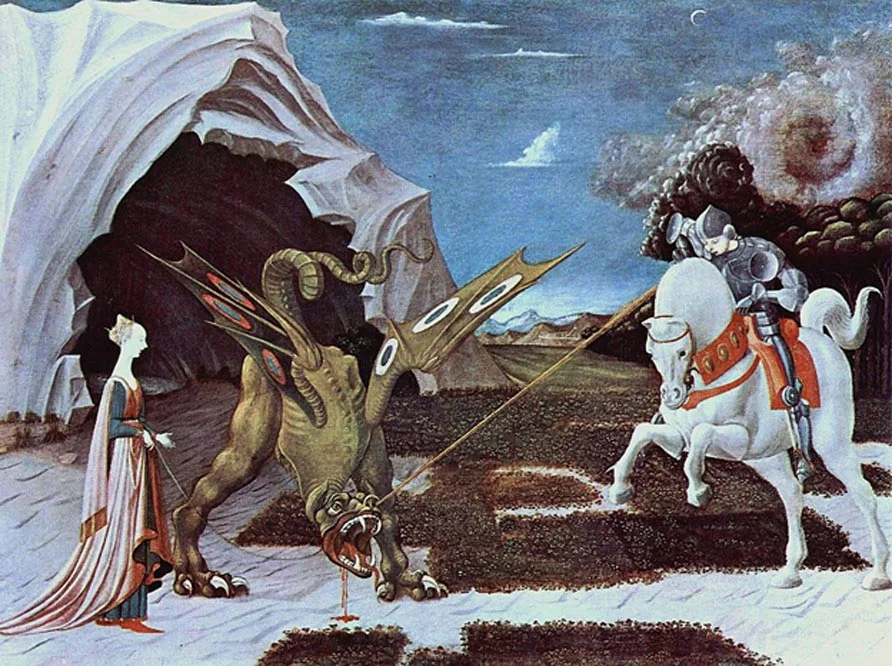St. George and the D(r)agon
Rumor has it there's a new Dungeons and Dragons out there, and we here at the Illuminerdy are justifiably excited. A wise man once said there's no better (and certainly no more lavishly detailed) campaign setting than the real world, it's only real disadvantage is a regrettable lack of dragons. But maybe that's not such a problem. The real world is chock full of the fantastic if you know where to look. Let's start with St. George and the Dragon.
The Legend
In Libya there was a city called Silene, set on the edge of a great body of water. A powerful, venomous dragon lived in this lake (or pond, or oasis, or even bay), where it threatened to poison the land. In order to appease the beast, Silene's pagan king demanded that his people provide two sheep to the dragon every day. Eventually, the dragon tired of this meager (but manageable) sacrifice, and demanded more. And so the king arranged a lottery for all of the families in the city; when each family's lot was drawn, they were to choose one of their children and feed them to the dragon in their turn.
This continued for some time, until it came to pass that the king's lot was drawn. His only daughter, the princess -- sometimes called Sabra -- was to be sacrificed to the monster. The king offered the people all his wealth -- and half his kingdom -- if another family would volunteer to sacrifice their child in Sabra's stead. They refused.
As Sabra stood on the water's edge, waiting for the dragon to emerge, a knight -- the man who would become St. George -- rode by, and asked the obviously terrified princess what was wrong. The brave woman explained her plight, but nevertheless urged the knight to flee the poisoned land of Silene in order to save himself. The valorous knight vowed to remain at her side until the dragon appeared, and to protect her if he could.
And then the dragon appeared, rearing out of the lake to menace the princess and the knight. George made the sign of the cross, lowered his lance, and charged the dragon, giving it a terrible (and possibly mortal) wound. He then took the princess's girdle, and wrapped it around the dragon's neck, and led the now-defeated dragon to the city gates.
With the princess Sabra beside him, George called out with a great voice, offering to slay the creature once and for all if the king and all the people of Silene would be baptized into the Christian faith. They enthusiastically agreed. And so George drew his great sword Ascalon and struck the dragon's neck from its body.
Years later, the now-christian king built a church on the site dedicated to the Virgin Mary (and, eventually, to George). As the final altar stone was laid, a miraculous spring began to flow from the altar, from which flowed waters which were said to cure all diseases.
Will the Real St. George Please Stand Up?
The version of the St. George legend above is largely drawn from the medieval Golden Legend, a hagiography compiled in the mid-13th century by the Archbishop of Genoa, Jacobus de Voragine. Other versions of the tale put the dragon in Lebanon, Palestine, Egypt, or even Wormingford, England. The English version (to be given some weight, considering that George is the nation's patron saint) places the climactic battle against the dragon on the River Stour, and casts George the Dragonslayer as Sir George Marney. There's even a mound in the village said to mark the gravesite of the beast. Identity problem solved, right?
Not quite.
Even aside from the obvious Libya/England mismatch, Jacobus makes George a contemporary of the Roman co-emperors Diocletian and Maximius, which would place the events of the legend sometime between 286 and 305 CE. The earliest surviving references to the dragon tale come from 7th century Georgia and Cappadocia (then a Roman province, now part of modern Turkey), and indeed even those versions of the legend seems to consistently place George's origin as somewhere in the Eastern Roman Empire: most consistently in Cappadocia itself.
Church historians are confident that the "real" St. George was born in Palestine to a Cappadocian Christian family of Greek extraction. This George became a Roman Tribune, probably never killed (or even encountered) a dragon, and was killed by Diocletian in 303 CE for refusing to deny Christ and make a token sacrifice to the Roman gods. Still pretty ballsy, but as a dragonslayer he's off the mark.
Unless that isn't the George we're looking for.
The Other Georges
The Ossetians -- a Scythian/Persian people who now live primarily in the Caucasus mountains in modern-day Georgia trace their versions of the St. George legend to a pagan warrior-god they called Wasterzhi (or sometimes Uastyrdzhi), typically depicted as white-bearded cavalryman. As the Ossetians converted to Orthodox Christianity in the Middle Ages, they quickly identified Wasterzhi with St. George, and indeed it is possible that the original Ossetian legends gave rise to the later tales of St. George.
The St. George legend also closely parallels the still earlier Greek legend surrounding Perseus (in the St. George role) and Andromeda (substituting for Sabra), although the reason that Andromeda is found in such dire straights is much clearer in the Greek version.
Andromeda's mother Cassiopeia, queen of the African kingdom of Aethiopia, idly boasted of her daughter's great beauty, ultimately declaring Andromeda to be fairer than the Nereids, Poseidon's own daughters. Enraged, the sea god sent a sea monster called Cetus to terrorize the kingdom. Andromeda's father, Cepheus, traveled to Libya (!) to speak to the the Oracle of Ammon (which the Greeks alternately Hellenized as an aspect of Zeus or Apollo, but who was probably actually the Egyptian Amun-Ra) to seek guidance on how to appease the monster and the God who had sent it. The oracle's instruction was simple: Andromeda was to be sacrificed.
As Andromeda was chained to a rock (customarily believed to be in the harbor at Phoenician Jaffa, now a suburb of Tel Aviv...which is, admittedly, a long way from Aethiopia) to be sacrificed, the Greek hero Perseus happened by, saw the princess in danger, slayed the monster, and took Andromeda as his wife. You don't get much more D&D than that.
It's also worth noting that, according to the Greek Myth, their children would go on to found the nation of Persia...eventually begetting the Ossetians, of course.
Even all this may be merely a reflection of an even older Egyptian tale of Horus's defeat of his uncle Seth -- who, at the time, had taken the form of a giant crocodile, of course. But maybe you'd call that a dragon.
Hunting Dragons
It would be easy (and boring) to suggest that the recurring motif is nothing more than that -- a literary repetition. You're not here for that. You're probably already thinking that all these dragon-slayers are connected -- perhaps in a lineage stretching back to a time before the first stones of the pyramids were laid. Not a bad place to get a couple of PCs, especially considering that you could drop them into any era from ancient Egypt right up through the Crusades.
In classical times, "Libya" was often used to refer to the entirety of Northwest Africa -- what we now call the Maghreb. This identification was often carried through to medieval sources. As a result, St. George's Silene could really be anywhere in modern Libya, Tunisia, Algeria, or Morocco. Ancient Carthage (now Tunis, Tunisia) -- the great enemy of Rome -- sat on a natural harbor between freshwater lakes, and is believed to have practiced child sacrifice to the god Baal Hammon. Perhaps, in your game, this hungry demon god manifests as a dragon?
Real-life scholars identify the Carthegenian Baal Hammon with the Canaanite Moloch, or the Phoenician Dagon...who was also the patron deity of sea-monster menaced Jaffa, natch.
Even leaving aside the Lovecraftian possibilities of tying this all into the Cthulhu mythos version of Dagon, you could easily make your PCs participants in the "real" story behind the St. George legend as Roman soldiers -- perhaps themselves heirs to Perseus, or even Horus -- in a fantastic version of the Punic Wars, fighting an already ancient cult with genuine monsters at their command. History is written by the victors, and it need not be a simple coincidence that nearly all first-hand records of Carthage's religion were destroyed by the victorious Romans in 146 BCE. Perhaps Herodotus is protecting mankind from secrets it is not meant to know?
Better still, set your campaign in the Byzantine era, or even during the Crusades, with all that magic and miracle of the Golden Legend still part of the world. Your Silene can be an Islamic Emirate basically anywhere in North Africa or the Levant, and your dragon an awakened creature from a forgotten age.
All that said, our feelings won't be hurt one bit if you want to dispense with the D&D style fantasy and go full-tilt toward pulp adventure or modern horror. What happens when someone finds Ascalon, the sword that killed the dragon...or maybe the body of the dragon itself? What happens if the beast wasn't quite, completely, all-the-way dead? What would it take to awaken it, and what would it do?
Forget that, if you must, and focus on the real, important questions: what would the rich and powerful give to control a magical spring whose waters cure all disease? More importantly, what would they do to keep it all to themselves?
Who says they haven't already done it?



